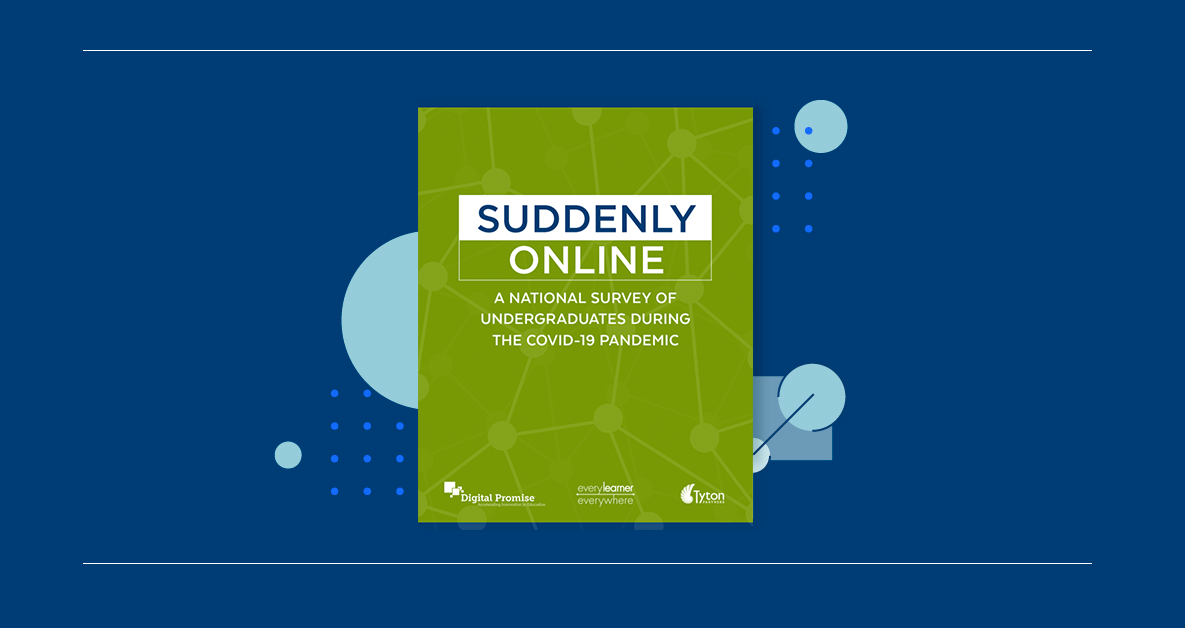It is no secret that our nation’s educational system has been severely affected by COVID-19. Overnight, millions of students, from primary school to college, switched from in-person classes to remote learning. Since the beginning of the pandemic—and before—Every Learner Everywhere has worked with its network partners to research technology innovations in order to better provide colleges and universities with insights and solutions for supporting digital and online instruction.
In collaboration with Every Learner Everywhere, national surveys recently conducted by Every Learner network members Digital Promise and Tyton Partners point to how we can learn from college student and faculty frustration during COVID-19. More than 1,000 students and over 4,000 faculty members submitted survey responses between May and June 2020, and here are some of the key takeaways that were discovered:
Course Satisfaction has Significantly Decreased
After schools shifted to all-online courses during the pandemic, college students’ satisfaction with their courses dropped sharply. Fifty-one percent of college students reported that they were very satisfied with their classes before COVID-19. After the courses moved to remote instruction, only 19 percent of students were very satisfied.
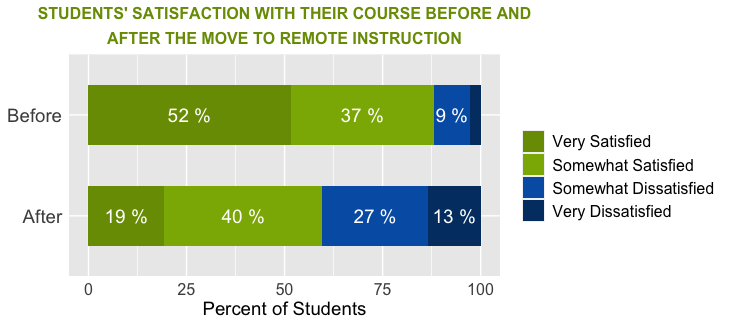
Credit: Suddenly Online, Digital Promise in partnership with Every Learner Everywhere and Tyton Partners, 2020
Students’ Problems are Complex Overall
The most common challenge faced by all students post COVID-19 was staying motivated to do well in their courses, which 79 percent saw as a problem.
Other issues cited as foremost on students’ minds included:
- 55 percent reported not being able to find a quiet place to do course work or study
- 54 percent found difficulty fitting their courses into their family or home responsibilities
- 54 percent did not know where to go for help with the course
- 45 percent felt too physically or emotionally unwell to participate
- 31 percent struggled with fitting the course in with a work schedule
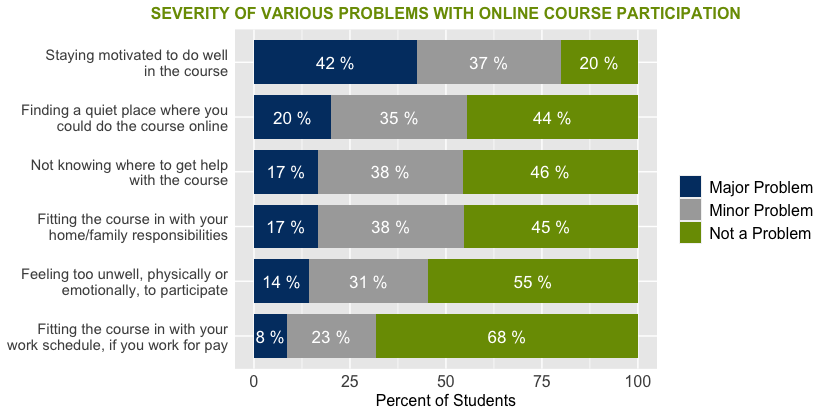
Credit: Suddenly Online, Digital Promise in partnership with Every Learner Everywhere and Tyton Partners, 2020
In addition, inequitable access to internet connectivity and devices for online learning were also associated with students’ struggles during the shift to remote learning. A considerable number of students experienced problems with their internet connections (44 percent) and software or computing devices (23 percent) that were serious enough to impede participation in their courses. For lower-income households, these challenges were magnified.
Disparate Experiences for Traditionally Underserved Students
The post-COVID-19 problems students faced with online course participation were not uniformly
distributed. Survey results shed light on the differential challenge of online course participation for college students from different race/ethnicity groups.
Hispanic students reported a greater number of challenges to their continued course participation after instruction went online. For example:
- 27 percent found difficulty fitting their courses into their family or home responsibilities, compared to 12 percent of non-Hispanic White students
- 27 percent reported not being able to find a quiet place to do course work or study, compared to 16 percent of non-Hispanic White students
- 21 percent felt too physically or emotionally unwell to participate, compared to 12 percent of non-Hispanic White students
- 24 percent did not know where to go for help with the course, compared to 14 percent of non-Hispanic White students
The frequencies of challenges among Black students were generally in between those for Hispanic students and those for non-Hispanic White students. One interesting difference was that the most prevalent challenge overall—staying motivated to do well in the course—was similarly common among Hispanic students (45 percent) and non-Hispanic White students (42 percent); but, Black students were less likely to perceive staying motivated as a major problem (31 percent).
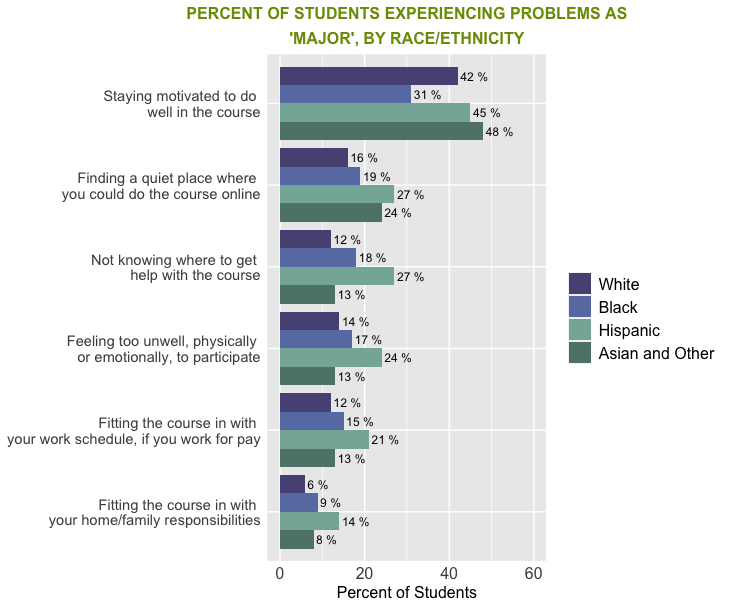
Credit: Suddenly Online, Digital Promise in partnership with Every Learner Everywhere and Tyton Partners, 2020
Faculty Members Must Adapt Too
The drastic education changes not only affected students, but also faculty members. Over half of faculty members (51 percent) noted they made changes to learning outcomes. Seventy-one percent of instructors even moved to incorporate a form of pass/fail grading.
Despite the rushed transition to remote teaching, most faculty walked away with an improved perception of online learning: Forty-five percent noted that their perception of online learning had shifted to be more favorable. And when a greater number of instructional practices were used, faculty were also more likely to report higher levels of satisfaction with student learning.
But as a new semester approaches, many faculty reflected a concern over student readiness for fall courses. Faculty teaching introductory level courses in particular are concerned at higher rates about remediation and equity gaps. Fifty-seven percent of faculty plan to adopt digital tools to supplement their core curriculum materials.
Engaging students was the most frequently cited challenge this spring (61 percent), and 74 percent of faculty said “increasing student engagement in class” is a priority for the fall term.
Faculty Noted Serious and Ongoing Concerns About Equity and Access for Students
Not all populations could be equitably served in the transition to remote learning due to challenges that included technology access. Many faculty acknowledged these challenges for their students; one noted that “many of my students are low-income (low equipment in the home, poor to no internet access), and many students tried to complete course requirements (such as podcasts, turning in workbook sheets, or composing English essays) using cellular phones.” These access issues, in addition to challenges with family and work responsibilities and financial and health concerns brought on by the pandemic, compromised student learning.
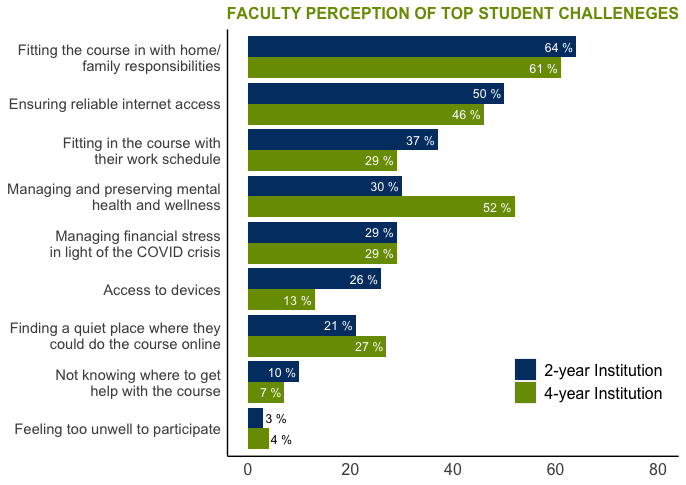
Credit: Suddenly Online, Digital Promise in partnership with Every Learner Everywhere and Tyton Partners, 2020
Looking Forward
Many faculty members said they came away with broader lessons that will inform their teaching and instructional practices. Faculty also reflected on insights from the spring term that will inform their instruction in the future, even in face-to-face settings. These lessons include the use of more frequent assessment and real-time feedback from students about their learning in order to adapt instruction; breaking content into smaller pieces to more readily assess and adjust learning; and the use of remote communication features, like chat functions, to enable quieter students to interact more confidently.
During this time, it is hard to predict what the future holds for remote learning and student outcomes, but one thing is certain: The increased use and adoption of digital learning tools and techniques to enable learning and flexibility is here to stay. The survey insights provide valuable data that institutions of higher education should keep in mind as faculty continue to implement digital and online learning opportunities in this challenging new environment. Through improving the delivery and use of high-quality digital courseware and tools, we must prepare to provide students of all backgrounds a fair opportunity to receive an equitable experience – no matter where they are.
Full versions of both reports are available online:
Suddenly Online: A National Survey of Undergraduates During the COVID-19 Pandemic
Time for Class: COVID-19 Version – Part 1: A Survey of Faculty During COVID-19



